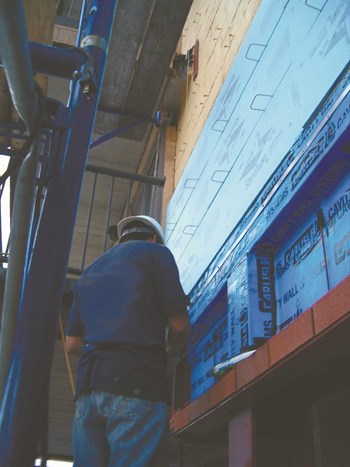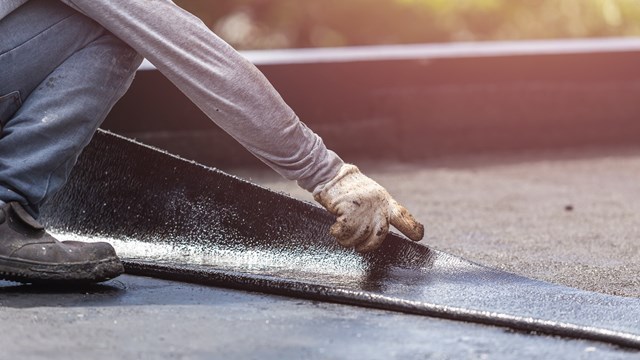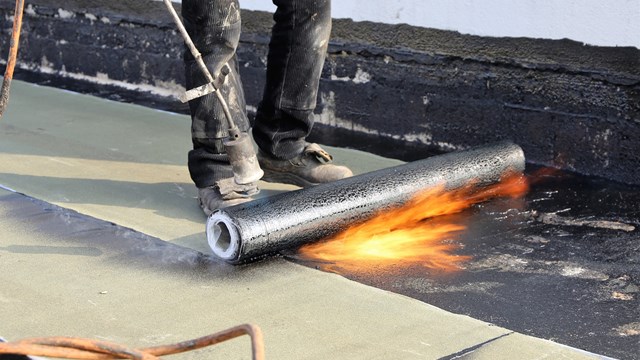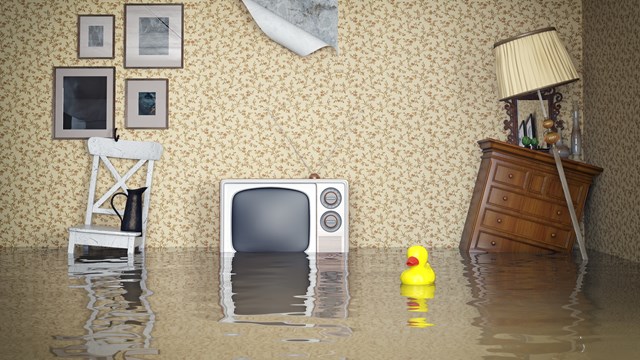
Residential buildings are constantly under attack—not by barbarians or marauding bandits, but by a force far more subtle and insidious. The most tenacious enemy of a residential building is not fire or structural collapse—though a building obviously should be protected from such catastrophes. It’s water. Left unchecked, simple moisture can quietly infiltrate your building envelope and wreak havoc throughout.
Water damage usually doesn’t have the same dramatic and immediate impact that a fire has on a building, but the damage caused by water infiltration can be problematic for years, even long after the initial leak has been resolved. Mildew and mold are common problems associated with water infiltration in a building, and are not only gross to look at and tough to eradicate but may also pose health threats to residents. Over time, water seepage can also erode a building’s components, compromising their structure and necessitating expensive repairs.
Because of these potentially devastating effects, co-op and condo boards, managers, and staff members should have a general understanding of the makeup, maintenance, and repair of their building’s waterproofing systems. While a building’s superintendent or property manager should be the first line of defense against leaks, broken pipes, and so forth, board members and residents do play a role in protecting their building from the ravages of water. Watchful eyes now can save many thousands, or even millions of dollars in repair costs later.
Keeping Dry
Every residential building has mechanisms that prevent water from seeping into the structure, but even when these systems are in top condition, they don’t make the building truly waterproof. Rather, they help to make the building resistant to water infiltration. The degree to which the systems keep the building dry depends upon how well they were installed, and how they are maintained.
The roof of a building is the most important linchpin of a building’s waterproofing system, but the drainage system for the roof—be it the downspouts on small buildings or the larger, internal roof drainage pipe known as a “leader” that is found in larger buildings—is also vital in keeping a building dry. Because the leader and downspouts take water off of a roof when it rains or snows, even a small blockage of that drainage system can back things up and quickly cause water damage to the building.
Most roofs in the city of the flat roof variety—are made up of several different types of material layered together—like the different levels of a person’s skin. Those materials usually include a substructure of steel under a concrete deck, topped with a “vapor barrier” like tarred paper. Over that goes a layer of insulation several inches thick, which is in turn topped by a waterproof membrane—and a decorative decking material, in some cases.
The waterproof membrane functions much like the skin’s epidermis, serving as the first—though by no means impenetrable—line of defense against the outside environment. Unlike our skin, however, roofs can only be expected to last between 10 and 25 years.
“A lot of these buildings have rooftop gardens, and often the drains up there are not kept clean,” says Barry Grummer, co-owner of Kay Waterproofing in Manhattan. “If that drain is not taking water or snow off the building fast enough, [the culprit] is usually something silly, like not keeping the drain clean.”
Flashing on the roof, caulking around windows and doors, and mortar joints in a brick or stone façade also are integral parts of a building’s weather defense system. Keeping an eye on these various components to ensure that they are properly functioning is critical. It’s almost as important as correctly installing the mortar, flashing, or other system in the first place.
Failure to mind these critical aspects of a building’s makeup could cost residents more money in the long run, according to Grummer. “What happens is that people aren’t checking the building for leaks consistently, and a little bit of water will get in and start to cause damage. Good preventative maintenance is really important. People wait until things leak, and by then it’s a big deal.”
Of all the aspects of a building’s waterproofing defense, its roof should be the most waterproof, says Manhattan-based architect Douglas J. Lister, AIA. Often, water getting into a building is coming through the exterior walls, or through the junction between the wall and the roof, he notes.
“Roofs usually leak where they connect with the building,” Lister says. “Failing connections are the problem 90 percent of the time. With windows, often the leak is around the window.”
While it may seem tough to keep a building free of unwanted rainwater or melting snow, the task is not so onerous if people keep on top of it. A building can be nearly waterproof, providing that it gets the proper maintenance, says Andrew Wist, owner of Standard Waterproofing Co., in the Bronx. Part of that regular care should be routine check-ups. Standard Waterproofing workers inspect client buildings twice a year, in the spring and the fall, says Wist, and customers are given a report on the condition of the building after each inspection.
“If you take care of the building, you don’t have problems,” Wist says.
Getting Soaked
Water making its way into a building leaves telltale signs, for those who are able to spot them. Residents should be on the lookout for rust, which can quickly destroy property, or create damage that will cost a lot to repair. Rust stains can bleed through concrete or other masonry building exteriors, showing that metal inside or attached to the masonry is rusting and, hence, weaker and less structurally sound than it should be. One obvious place to look for rust on older buildings, Grummer says, is on the steel fire escapes.
“If you start seeing paint peeling on a fire escape, you have to take care of it immediately,” Grummer says. “Same thing with the vent stacks. That rust is telling you that you have to maintain it, or the flashing around the vent will fail, and you’ll have a water problem.”
In addition to creating the need for repairs, water leaking into a building can make the structure an uncomfortable place in which to live. No resident wants to have to leave a cooking pot out to catch water dripping through a ceiling, or deal with incessantly recurring mold. Such conditions can make residents consider filing lawsuits against the board or others involved in managing the building. And increased maintenance fees resulting from poor maintenance of a building and subsequent necessary repairs also might lead some residents to sue.
Water leaking into a building can not only divide residents, it also can literally divide the building itself. Leaks, if left unrepaired long enough, can weaken a building’s structure. Repairing such damage can be so costly that it might take years to do the work, and many years more to pay for it. The water problem often starts with a small leak or fissure, and gets worse from there.
“In addition to making a building uncomfortable to live in, serious leaks can cause structural damage to the building’s steel frame,” Lister says. “When steel is exposed to water, it will rust. The steel then expands, and opens up cracks in the building, and that lets in more moisture.”
Residents should look for cracking in the masonry on the exterior of a building. Such warning signs, like the rust stains, are saying that work needs to be done on the building. Even small cracks in the exterior of a building cannot be left unrepaired, because those cracks will allow the water in, to create more problems. Displacement of the building’s masonry work, such as when bricks or stones break away from each other and get off-kilter, also should tell residents to make the superintendent or property manager aware of the problem.
One of the most expensive types of water-related repairs to a building is wall repair work, Lister says. For example, a building might have a leak in a wall that only became obvious during a heavy rainstorm. “Ninety percent of the volume of rain will hit the roof. The problem is wind-driven rain. The solution might be fixing just one area of the wall,” Lister says.
Local Law 11 requires that residential structures undergo a total exterior façade building inspection every five years. An engineer and contractor will be hired to inspect the outer surface, and the engineer will write and submit to the board of directors a report on the building’s physical condition. If repairs are needed, the board might direct the engineer to write specifications for the work. Then the work will be put out to bid, and the board will review bids and pick a contractor for the job.
If the roof of a flat-roofed building needs to be replaced, a contractor will likely use a liquid membrane that is rolled out and cures over time to create a watertight seal.
Costs & Disruptions
The cost of a major waterproofing project varies, depending upon the size of the building and the amount of work that needs to be done. The price of a major waterproofing project for a mid-sized building in Manhattan could start anywhere between $100,000 and $300,000, but the cost could range up to $2 million, Wist says. According to Lister, most large waterproofing jobs range in cost from $300,000 to $1.5 million. “Occasionally, a big job will cost $4 million. The median [cost] is probably $750,000,” he says.
How much time such a large project will take to complete depends not only upon the size and complexity of the job, says Wist, but also on the abilities of the contractor. “We currently have a $500,000 job, and we’re doing it in three months,” he says, but other jobs might take more or less time, depending on various factors.
Because so many residential buildings—especially older ones—have masonry walls, some waterproofing work can be quite disruptive to residents’ daily lives. Wall waterproofing jobs, or work on parapets, can be annoying. “You’re talking about a lot of noise and dust, and scaffolding has to be put up, and sidewalk bridges have to be put up,” Grummer says. “It’s difficult to take brick or concrete out of a building and not interrupt the people who live there.”
While some experts caution against using contractors who employ many subcontractors, the scenario really is more about the reliability of the contractor and its subs, rather than the subcontracting itself, says Steve Katz, Kay Waterproofing’s co-owner.
“We do some subcontracting, but we’ve been working with the same people long-term. The same employees and subcontractors have been with us for a long time,” Katz says.
Whether your building is a brand-new glass-and-steel construction or a prewar landmark, the impact of an untreated water leak can be devastating to both individual residents and your building community as a whole. A program of conscientious maintenance, vigilant observation, and proactive prevention can save your building untold dollars and provide leak-proof peace-of-mind.
Jonathan Barnes is a freelance writer and a frequent contributor to The Cooperator and other publications.









Leave a Comment